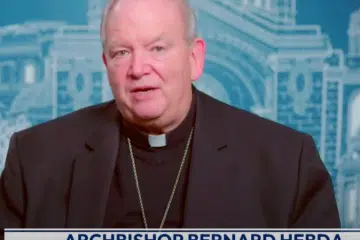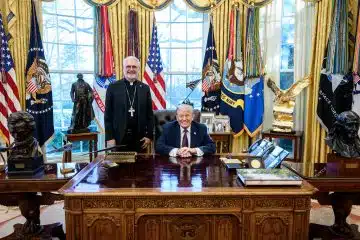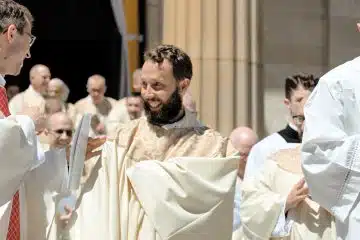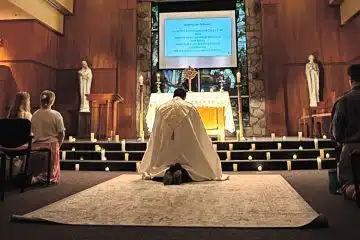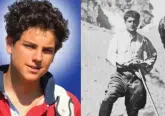Saintly superhero: When Marvel Comics told the life story of John Paul II
by Jonah McKeown
Denver Newsroom, May 5, 2020 / 02:52 am MT (CNA).- Pope St. John Paul II, who led the Catholic Church from 1978 until his death in 2005, is perhaps one of the most compelling figures of the 20th century.
Born nearly 100 years ago on May 18, 1920 in Wadowice, Poland, Karol Woytila— the future pope— endured the loss of most of his family, clandestinely studied for the priesthood while his country was under Nazi rule, and rose through the Church hierarchy while never ceasing to encourage his Polish countrymen to keep the faith while resisting Communist pressure.
He participated in the Second Vatican Council and, upon his election as pope, became the most widely-traveled pontiff ever and likely the most-seen person in the history of the world. He was an academic, and widely regarded as a genius, but also a man of simplicity and humility.
He survived a brutal assassination attempt in 1981, crediting Mary’s intercession for his survival and extending forgiveness to his attacker.
“He’s the exemplar of the fact that a life wholly dedicated to Jesus Christ and the Gospel is the most exciting human life possible,” George Weigel, John Paul II’s biographer, told CNA.
“This man lived a life of such extraordinary drama that no Hollywood scriptwriter would dare come up with such a storyline. It would just be regarded as absurd.”
His compelling life story has been told and retold many times, including on the big screen.
But did you know that John Paul II’s life story was once the subject of a Marvel comic book?
Printed in full color and featuring dramatic, stylish visuals, the 1982 comic chronicles the pope’s life, from his childhood in Poland all the way up to the attempt on his life by a would-be assassin.
Marvel, which Disney purchased in a multi-billion dollar acquisition in 2009, is one of the largest entertainment companies in the world, and the purveyor of such iconic characters as Iron Man, Spider-Man, and Captain America.
So what persuaded the Marvel executives to green-light a comic book about the then newly-elected pope?
‘Marvel’s Man in Japan’
It all started with Gene Pelc— a New Yorker and Marvel representative living in Japan.
Pelc— whose wife is Japanese— had moved to Japan in the 1970s in order to report back to Marvel on how the comic book company could adapt its products for a Japanese audience.
Pelc was tasked with licensing Spider-Man to play on Japanese television, and was largely successful at what he did, earning the moniker “Marvel’s Man in Japan.”
Pelc told CNA that he and his family went— and still go— to Mass at the Franciscan Chapel Center, a community of English-speaking priests in Tokyo.
Japan was then— and remains today— a very non-Christian country, with Catholics comprising less than half of 1% of the population.
One day, a priest named Father Campion Lally approached Pelc at the Franciscan Chapel Center with an unusual proposition. The eight-hundredth anniversary of St. Francis’ birth was coming up in 1982, Fr. Lally said…what if, to commemorate it, Marvel produced a comic book about the life of St. Francis?
Pelc liked the idea, and wondered whether it would prove popular amongst Catholics in the US. Fr. Lally was adamant, however, that the comic be marketed to non-Catholics as well.
“The real reason I want this done is to reach an audience the Church doesn’t normally reach,” Pelc remembers Fr. Lally saying.
“’I want to take St. Francis out of the birdbath’ was his exact comment.”
Pelc called up Stan Lee— a legendary Marvel comic book publisher— who apparently liked the idea. But when Pelc pitched the idea to the higher-ups at Marvel, they weren’t quite so supportive at first.
“They all said: Gene, you’ve been in Japan too long. No one wants to hear about that. They want to hear about superheroes,” Pelc remembers the executives telling him.
Pelc was able to appeal to the financial sensibilities of the executives to help his case, however— the Paulist Press, a U.S.-based Catholic publisher, had expressed interest in purchasing some 250,000 copies of the comic upon its release.
Needless to say, the prospect of a minimum of 250,000 copies sold— when a popular comic at the time could be expected to sell around 150,000 copies— was enough to sway the executives to approve the project.
Father Roy Gasnick, a Franciscan priest and director of communications based in New York, helped Marvel writer Mary Jo Duffy to write the story of St. Francis’ life for the comic. Fr. Gasnik was, by all accounts, a massive comic book fan himself.
Then the artists at Marvel did their magic, and produced the comic entitled “Francis: Brother of the Universe,” which hit stores in 1980.
Helped by the Paulist Press’ large order, “Brother of the Universe” proved to be a hit, both critically and commercially.
A new project
“The next step was pretty obvious to me, being Catholic and being Polish,” Pelc said.
“Pope John Paul II was extremely popular in the world at the time; he was traveling much more than the old popes did previously. And he was actually coming to Japan.”
John Paul II was the first pontiff to visit the country. The pope arrived in Japan in February 1981, to a small but enthusiastic welcome.
The pope’s visit galvanized Pelc, who was still riding high on the success of the St. Francis comic. He began looking into the possibility of producing another religious-themed comic for Marvel.
A friend of Gene’s introduced him to Father Mieczyslaw Malinski, who was a friend of the pope’s back in Poland during the war. Fr. Malinski apparently consulted with the pope himself about what he thought about the idea of turning his story into a comic.
According to Pelc, John Paul II was supportive of the idea, as long as Fr. Malinski himself worked with the comic book team on the project.
So, the Marvel team was off to the races yet again. The first step? Research. And a lot of it.
Most of the information came from Fr. Malinski, but the story still had to be adapted to fit into the panels and speech bubbles.
That task fell to Steven Grant, a young freelance comic book artist who at the time was living in New York and working for Marvel. He had heard that Marvel was producing a second religious-themed comic, but he didn’t think much of it— he assumed that Mary Jo Duffy would be tasked with writing this one, too.
Instead, Marvel’s editor-in-chief called Grant into his office and asked him to take on the task of writing the John Paul II comic book.
“I got involved because I was expendable at the time,” Grant told CNA.
“I wasn’t one of the artists they particularly wanted writing the Fantastic Four that month,” he laughed.
“And they knew I was Catholic— that was my big credential.”
For Grant, working on a comic book about John Paul II— which the team always referred to as “the Pope Book”— was both ordinary, in the sense that the writing process was not markedly different than other comic books; and extraordinary, given that the subject matter was not only a living person, but also the leader of a 1-billion strong worldwide religion.
“No one was worried about offending him, but there was a lot of room to offend a lot of people if we did a bad job with it,” he said.
Bumps in the road
The project experienced two major roadblocks the year before it was released, the first of which was the attempt on John Paul’s life in May 1981, in the midst of the comic’s production.
Instead of dropping the project, the Marvel team wrote the events of the assassination into the book itself.
In addition, communicating with Fr. Malinski would prove more difficult than the team at Marvel had expected.
On Dec. 13, 1981, a general named Wojciech Jaruzelski appeared on television sets throughout Poland. In a video message repeated over and over again, the general declared martial law, and ordered troops to suppress the Solidarity movement, a trade union rooted in Catholic principles that opposed Communism.
Many striking Solidarity workers would die in the next few days, as Polish troops fired into groups of them.
After John Paul’s visit to his native Poland in 1979, it would be another decade before the Solidarity Party in Poland, with the pope’s encouragement, would finally gain a majority in Parliament, and, largely peacefully, the country would shrug off the shackles of Communism.
To make matters worse, the turmoil in Poland was taking place in the middle of the comic book’s production schedule, and the Marvel team needed Fr. Malinski’s insights in order to get the comic book written.
The Communists restricted much of the communications in and out of Poland during that time. Pelc said he remembers receiving smuggled communications from Fr. Malinski, which he brought to his father in New York to have translated from Polish to English.
Apart from Fr. Malinski’s contributions, Grant says he simply put his nose to the grindstone and read up on as much as he could about the pope’s life.
“It was a little pre-internet,” Grant chuckled.
“I figured anything I found three or four references to was probably accurate.”
His total research spanned about two months, he says, but the actual writing process was only a couple of weeks long, spurred on by Marvel’s tight production schedules.
Legacy
Finally, in 1982, the comic book hit the shelves. Thanks in large part to Catholic agencies buying up the edition, somewhere in the neighborhood of 1 million copies made their way into the world.
For a young comic book artist, it was quite the windfall. Grant said he was able to pay off his student loans when he received the royalties for the comic the following year.
So, did the pope himself ever get a chance to see himself as a Marvel hero? According to Pelc, he did. A Marvel executive flew to Rome and presented the pope with a leatherbound edition.
The success of the first two religious-themed comic books led to a third, this time about another future saint— and friend of John Paul’s— Mother Teresa of Calcutta.
Although Pelc was not able to assist with that project, that comic also proved successful, though it was the last of the major religious-themed comics that Marvel produced. That comic even won a Catholic Press Association award in 1984.
In the four decades since the John Paul II comic book’s release, several members of the team that worked on it, including the artist who created the drawings, have died.
Pelc and Grant have gone their separate ways. Grant is still a freelance comic writer, and does writing work for Marvel “once in a blue moon” when they call him up.
Though the “Pope book” remains just one of the hundreds of projects that Grant has worked on over the years, he said he remembers walking into his local laundromat in New York a few months after the comic’s release, and being surprised to see the comic’s cover framed and hung proudly on the wall.
Though Grant never told the owners of the laundromat— clearly devout Catholics— that he was the author of the comic, he said it brought him pride that they valued it so highly.
Pelc, who still lives in Tokyo, owns a company that sells merchandise for musical artists. He said he still gets asked to this day— mostly by parishioners at the Franciscan Chapel Center— about Marvel’s religious comics, he says.
On the side, Pelc still has a passion for telling compelling Catholic stories. He is currently working on a book about the late 16th-century 26 Christian martyrs of Japan, and hopes eventually to adapt the story into a screenplay.
For his part, Pelc says he thinks it unlikely that a company like Marvel would produce something like this again. But he’s glad that by means of the “Pope book,” he and Grant and the entire team were able to tell a good story, in a world inundated by bad stories.
“That man deserved to be known by more than just people who go to church. He was an everyman pope, and I, being Polish, loved him,” he reflected.


